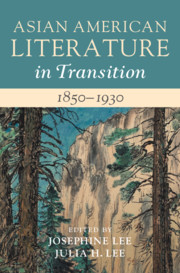Book contents
- Asian American Literature in Transition, 1850–1930
- Asian American Literature in Transition
- Asian American Literature in Transition, 1850–1930
- Copyright page
- Contents
- Illustrations
- Notes on Contributors
- Series Preface
- Introduction: Asian American Literature in Transition, 1850–1930
- Part I Empire and Resistance
- Part II Bodies at Work and Play
- Chapter 7 Objects of an Orientalist Gaze
- Chapter 8 Labor, Freedom, and Typicality in Chinese Canadian Railroad Fiction
- Chapter 9 Bret Harte’s “Heathen Chinee” in US Literature after Slavery
- Chapter 10 On the Genealogy of Asian American Drama
- Chapter 11 Decorative Orientalism
- Part III Crossings
- Bibliography
- Index
Chapter 7 - Objects of an Orientalist Gaze
Chinese Immigrants in American Silent Film
from Part II - Bodies at Work and Play
Published online by Cambridge University Press: 27 May 2021
- Asian American Literature in Transition, 1850–1930
- Asian American Literature in Transition
- Asian American Literature in Transition, 1850–1930
- Copyright page
- Contents
- Illustrations
- Notes on Contributors
- Series Preface
- Introduction: Asian American Literature in Transition, 1850–1930
- Part I Empire and Resistance
- Part II Bodies at Work and Play
- Chapter 7 Objects of an Orientalist Gaze
- Chapter 8 Labor, Freedom, and Typicality in Chinese Canadian Railroad Fiction
- Chapter 9 Bret Harte’s “Heathen Chinee” in US Literature after Slavery
- Chapter 10 On the Genealogy of Asian American Drama
- Chapter 11 Decorative Orientalism
- Part III Crossings
- Bibliography
- Index
Summary
While the stereotype of the oriental villain and the practice of yellowface have been discussed by scholars, less has been said about how practices of cinematography and editing more subtly controlled the representation of Asian immigrants in American film. This chapter examines how orientalism informed American feature-length silent films, including Chinatown Nights (1929) and A Tale of Two Worlds (1921), by visualizing the negative impact of Chinese immigration, depicting the investigation of Chinatown’s people and spaces by white American heroes, and concluding with the reassertion of occidental dominance over oriental people and spaces. In contrast, films such as The Tong-Man (1919) presented resistance to cinematic regulatory gazes by casting Asian American actors in key roles, including silent film’s only Asian American star, Sessue Hayakawa, to challenge those orientalist constructions of subjectivity and objectivity. This chapter demonstrates that, while many silent films depicted Chinatown as a space for white American adventure and Chinese immorality, some demonstrated an appreciation for Chinese immigrants who desired the American dream and assimilation in America’s melting pot.
Keywords
- Type
- Chapter
- Information
- Asian American Literature in Transition, 1850–1930 , pp. 121 - 135Publisher: Cambridge University PressPrint publication year: 2021
- 1
- Cited by

